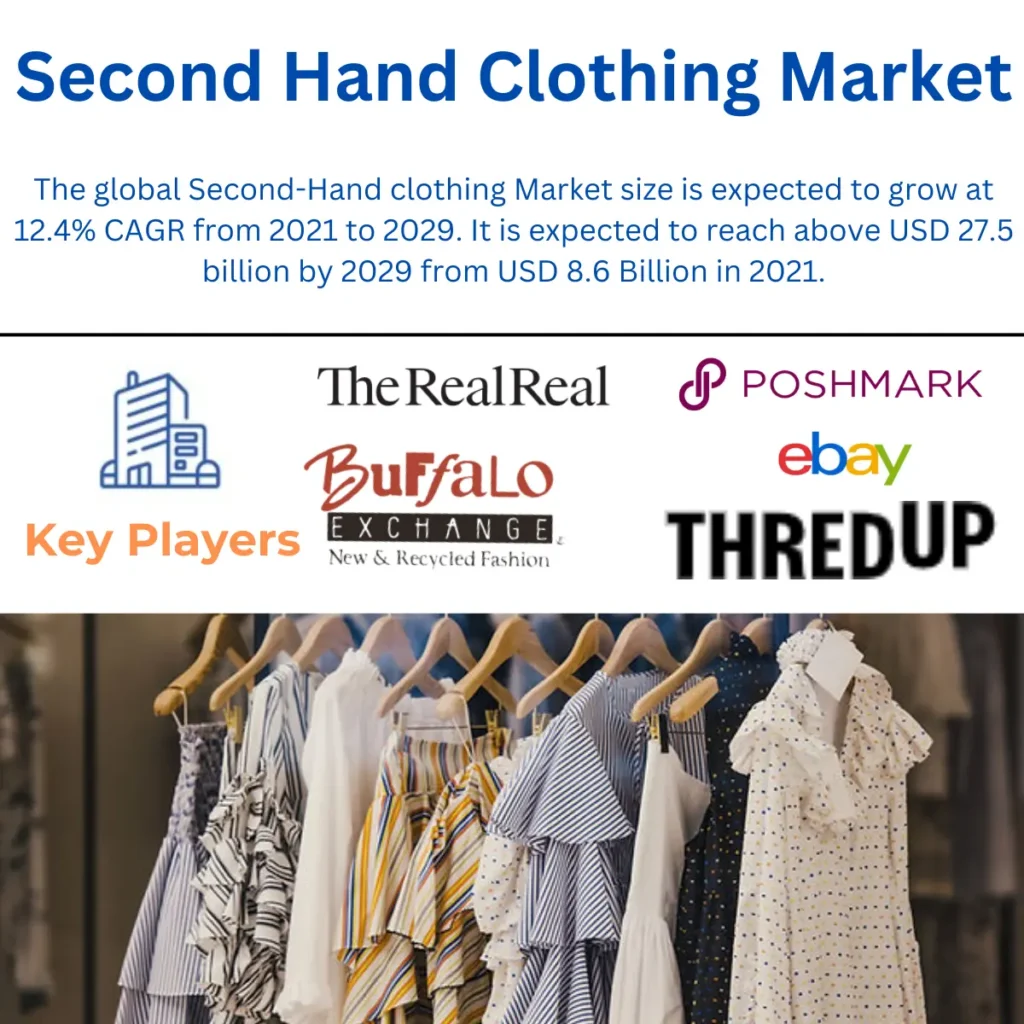Thrifters list cost savings and environmentally friendly shopping as advantages.
The market for used clothing may grow faster than that of fast fashion as more people become aware of the financial, social, and environmental advantages of thrift shopping. In a recent analysis, thredUP, an online consignment and thrift retailer, predicted that the global second Hand clothing market for used garments will increase by 127% by 2026, three times faster than the apparel sector as a whole.
The global Second Hand Clothing Market for used and resale clothing was projected to be valued at USD 8.6 billion in 2021. It is expected that this worth would increase significantly over the next several years, nearly doubling in size between 2022 and 2029 to reach a valuation of USD 27.5 billion.

Generation Z
Younger consumers are mostly responsible for the used clothing industry’s rise. According to a 2021 global survey, millennials and Generation Z were the generations most likely to purchase used clothing. It is thought to be a less expensive and more ecologically friendly method of buying clothing—two points that are particularly important to younger shoppers. Secondhand clothing’s lower costs also increase accessibility to otherwise unaffordable clothing. Secondhand Clothing, a personal luxury good, had grown as a result of this.
Online platforms
Smartphone apps, which offer users more ease and variety, are one common way that younger generations purchase used clothing. In December 2022, Depop reported 354,000 monthly downloads globally, albeit a significant decrease from the 2021 total. Of course, a lot of individuals continue to purchase used clothing from thrift stores.
In-depth industry statistics and market share insights of the Second hand Clothing Market sector for 2020, 2021, and 2022. The Second hand Clothing Market research report provides a comprehensive outlook of the market size and an industry growth forecast for 2023 to 2029. Available to download is a free sample file of the Market Report PDF
The active markets
Following an economic downturn that hit many European nations, the second-hand apparel industry in this region has flourished. The market for used clothing is booming in Bulgaria, and Mania, a company that deals in used apparel, has opened stores in Romania and Greece as well as expanding its operations. The main importers of used apparel are from the United States, Canada, Denmark, and Switzerland. Sevdalin Spasov, the owner of Mani “In 2014, the second-hand clothes market in Bulgaria and Europe is developing under the direct influence of the conflict between Russia and Ukraine.”
The company Hada, one of the largest in Hungary, had to spend an astounding 1.6 million to establish a sorting hall due to an increase in demand for these clothes. Every week, Britain exports between thirty and forty tonnes of unwanted clothing to Hada. Even though the economic downturn is ending in Western Europe, things are still not getting better in Eastern and Central Europe. With a staggering debt of 80,876 million, Hungary is seeing a booming second-hand clothes sector, with 56 million pieces sold last year.
Poland’s market has also expanded considerably. In Poland, almost 40% of consumers say they prefer to purchase at retail stores that sell used clothing. In 2013, the nation imported 100 million worth of used clothing. Germany, Scandinavia, and Britain are Poland’s top suppliers of used apparel. Retailers of used clothing in Croatia are likewise doing very well.
At the moment, markets for used clothing are developing in eastern and central Europe, but the oldest and most developed marketplaces worldwide are found in African nations like Kenya. Every year, Kenya imports about 100,000 tonnes of used clothing. The market for secondhand apparel not only boosts employment in the area but also contributes to the government’s customs revenue. Another African country with a strong hand-me-downs market is Sierra Leone. Seven out of ten people here make less than USD 2 each day, hence the majority of the population dresses in used apparel.
Regional-Wise Insights
How is Second Hand Clothing Market Progressing in India?
“Increasing Demand for Special Event Clothes to Boost Sales in the Region”
India is one of the marketplaces for used clothing that is expanding the fastest, accounting for 18.2% of the market in all of South Asia. Additionally, EC projects that the fast-expanding population, rising disposable income, and sharp increase in the number of startups selling used clothing will propel the expansion of the secondhand apparel market in India at a CAGR of 17.9% over the forecast year.
Comparably, a major factor driving sales growth is the nation’s expanding need for special event clothing, and this trend is probably going to continue. Special occasion clothing is in high demand in India. Indians take great care when choosing their formal wear.
The demand for worn clothing is also being driven by local celebrities making it fashionable and customers seeing the benefits of decluttering their closets.
In addition, advertising, the presence of several major rivals, and changing consumer tastes present the nation’s used clothing market with promising prospects.
How is the Second Hand Clothing Market Growing in the U.S.?
“Growing Trend of Quick Fashion to Aid the Growth of Second Hand Clothing Market in the U.S.”
According to Exactitude Consultancy, the United States is one of the most significant Second Hand Clothing Market places in the world, accounting for around 86.3% of the North American market. Throughout the projection period, the Second Hand Clothing Market is expected to grow at a CAGR of 21.2%.
The U.S. secondhand garment market is expanding due to several causes, including an increase in conscientious consumers, the prevalence of online retailers that allow people to purchase and sell pre-owned goods, including clothes, and the strong presence of prominent providers of pre-owned clothing.
Vintage clothing is one strategy to solve the labor and environmental issues associated with the apparel industry in a time of fast fashion and outsourcing. The idea that design trends resurface after a long hiatus and that vintage clothing has more character than contemporary clothing is what gave rise to the vintage fashion clothing trend.
What are the Factors Driving Sales of Second-hand Clothing in Australia?
“Increase of Multinational Secondhand Clothing Brands to Drive Market in Australia”
With a Second Hand Clothing Market share of almost 73.1%, Australia leads the Oceania used clothing market, which is expected to expand at a compound annual growth rate of 12.5% throughout the forecast period 2023 to 2029.
Due to consumers’ growing taste for designer clothing for a variety of occasions, there is a surge in the market for used clothing, which creates a significant demand for international secondhand clothing stores.
As a result, it is anticipated that the entry of international consignment stores into Australia will spur industry growth. Multinational labels are expected to feel more confident to expand in Australia due to increased demand from customers who have been exposed to their brands through social media.
Category-Wise Insights
Which Product Type Has High Demand in the Second Hand Clothing Market?
“Demand to Remain High for Secondhand Dresses and Tops in the Market”
According to Exactitude Consultancy, the dresses and tops category presently commands a substantial 39.0% market share in the entire used clothing industry. Additionally, throughout the projected term, dresses and tops sales are expected to increase at a CAGR of 11.4%. This can be linked to the growing global trend of used tops and dresses, particularly among women.
The global Second Hand Clothing Market is anticipated to expand shortly due to shifting consumer preferences, which will result in a big demand for dresses and tops among women. Customers are putting increased pressure on clothing makers to uphold their commitment to sustainability as they grow more aware of the impact that the industry has on the environment.
If you are interested in learning about Digital Marketing Click Here
